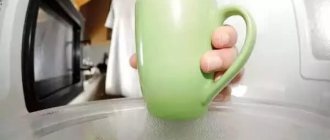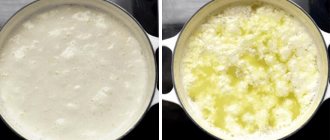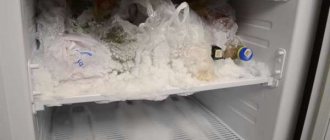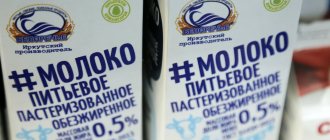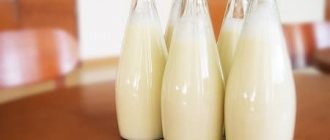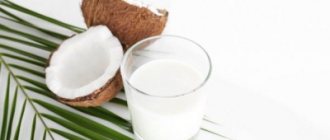In this topic, we’ll look at whether breast milk can be heated in a microwave oven, and we’ll also take a look at all the possible heating methods.
There are situations when a young mother simply does not have the opportunity to breastfeed her baby. For example, if she urgently needs to leave for work or study. In this case, pre-expressed, frozen milk comes to the rescue, which at a temperature of -19 ° C can retain its beneficial and nutritional properties for up to six months. But in order to feed the baby in this case, you need to warm up the breast milk. A simple and quick option immediately comes to mind - a microwave oven, but we will study the benefits and harms of this method in more detail.
Does heating affect the beneficial properties of human milk?
Heating, if done incorrectly, greatly affects the constituents of mother's milk. For this reason, it is not recommended to boil the product even after freezing. Some women sterilize their own milk during infectious diseases so as not to infect the child, but this gives the opposite result. When exposed to high temperatures, the benefit of immunoglobulins, which could help the infant’s immune system cope with the causative agent of the disease, is lost.
Myths about microwaves
Until now, even after a huge number of studies and tests, the results of which have been officially certified, colorful misconceptions about radiation, mutations and, at best, the uselessness of food after such processing are incredibly popular and widespread. And this is only a small part of the myths about the microwave.
There is also an opinion that any heat treatment is harmful to food, so there is no need to cook or heat it. There is, of course, some grain of truth in the latter, but only a grain. Some substances are destroyed during heat treatment, but this does not make the products “useless”.
How to warm up expressed milk
Expressed milk must be heated gradually. Sudden temperature changes are unacceptable. Depending on how the product was stored, an individual heating method is selected.
Frozen in the refrigerator
If the milk was stored in the freezer, to defrost it must be placed on the refrigerator shelf and wait until it becomes a homogeneous liquid consistency. It will take from 3 to 12 hours depending on the serving size. After this, the product must be carefully mixed and make sure that there is no ice left.
The next step is heating using a water bath, a special bottle system or warm running water.
Chilled in the refrigerator
Baby food that has been refrigerated or defrosted should be brought to a comfortable temperature. Warm water or a special heating device is used for heating.
Heating Recommendations
If parents of a newborn child are interested in the full and harmonious development of their baby, then they should familiarize themselves with the rules for using and storing expressed breast milk. These rules include:
- Before heating frozen milk, it must be thawed at room temperature;
- Thawed or reheated food cannot be re-frozen in the refrigerator;
- It is strictly forbidden to bring expressed breast milk to a boil;
- The temperature of the heated product does not exceed 37 degrees;
- Before feeding your baby, it is recommended to shake the milk and make sure it is warmed evenly;
- It is permissible to warm up baby food no more than once;
- A liquid thermometer is used to estimate the temperature of the product.
By following all the rules and regulations for the use of expressed breast milk, parents of a newborn do not expose their baby to the risk of receiving poor-quality nutrition.
And nutrition, as you know, is the basis of all life. Subscribe to our VKontakte group
Heating methods
Parents can choose any safe method of heating baby food: a warmer or water.
In a bottle warmer
When using a special system, you must study the instructions. On the device, select the desired temperature and set the heating time. With the help of the water in the device, any baby food will heat up quickly and without loss of quality.
Under running water
You can place the bottle under running warm water. It needs to be hot, but not scalding. If the product was stored in the refrigerator, the flow temperature should be increased gradually so that there are no strong changes.
In a water bath
To use this method, you need to take a pan of water and heat it over a fire. It is important not to bring the liquid to a boil. After turning off the gas, a bottle of milk at room temperature is placed in water. During heating, you should rotate the container with baby food so that the temperature changes evenly.
Can breast milk be heated in the microwave?
Microwave ovens today are objects of massive controversy, because they have not come to a common denominator - whether the devices are harmful or not. Especially, a lot of doubts creep in among mothers who want to warm breast milk in this way. But in order to understand everything, it is worth studying the principle of action and the very effect on the products.
How does the oven itself work?
- In a microwave oven, food heats up very quickly. After all, the water molecules found in any food begin to move under the influence of magnetron waves millions of times faster.
- To be precise, they make movements almost 5 billion times per second. Therefore, due to this “friction” of particles, rapid heating occurs. But they also move chaotically. Therefore, the end result is that due to electrical waves, food may lose its beneficial properties as molecules are destroyed.
The microwave still attracts a lot of debate regarding the benefits of its heating
Important: In 1991, American scientist Lita Lee proved that beneficial amino acids and antibodies found in food are destroyed and converted into compounds hazardous to health. And they can cause cancer and other terrible diseases in the future.
How does microwave oven affect breast milk?
- Therefore, the first thing a mother who decides to heat breast milk in a microwave needs to know is uneven heating of the liquid. As a rule, the bottom and near the glass walls will overheat in seconds, and the inside will be icy.
- Another danger is that breast milk should not be boiled! And near the walls, the rapid rotation of molecules in liquids often causes the boiling process.
- As a result, scientists have proven that the molecular compounds of certain sections of the protein, which heat up faster, are destroyed under the influence of electrical waves, and milk becomes not only useless and non-nutritious, but also dangerous for the child.
- The main advantage of milk over other products is the presence of antibodies, which have a beneficial effect on the human body, including children. And now these valuable antibodies are converted into isotopes!
- Particles such as immunoglobulins, which are vital for children's immunity, are also affected.
- In addition to all this, some scientists insist that carcinogens appear in products that are dangerous to the body.
- Mother's milk is enriched d -isomers. They attack the baby’s not fully formed nervous, cardiovascular and urinary systems.
Convenience and speed weigh on the significant disadvantages of this method.
But there are also advantages:
- you will spend much less time. The milk will heat up quickly. So much so that you need to make sure that it doesn’t run away;
- less hassle and more convenience - put a glass or bottle, open the lid, and after a couple of seconds take out the warm product.
Important: It is because of this uneven heating, overheating and “underheating” that certain particles are destroyed, which we talked about above. Therefore, children are prohibited from heating breast milk in the microwave!
But for older children, regular food can be heated in the microwave. By the way, even the famous doctor Komarovsky approves of this. But that's another conversation.
Advantages and disadvantages
Since many mothers still use the quick microwave method, it's worth talking about the advantages and disadvantages of this method. Among the main advantages:
- convenience;
- speed.
Perhaps this is where the benefit ends, since there are many more disadvantages:
- useful compounds die;
- milk can “run away”;
- pathogenic compounds are formed that negatively affect health.
No one says that you can’t heat, but you shouldn’t do it while caring about your health and the condition of your loved ones. Numerous studies put forward more factors “against” than “for”. Another proof of this is the fact that in Spain scientists have proven that such healthy broccoli, heated in a microwave, loses 98% of its beneficial qualities. So, whether or not to heat milk in the microwave is up to everyone to decide for themselves.
Why is it not recommended to heat dairy products in the microwave?
There are many horror stories about the adverse effects of microwaves. This miracle of technology never ceases to amaze many users, and not in a good sense of the word. There were also many statements that reheating dairy products is never recommended. Disputes on this issue still do not subside. Such gossip usually occurs on the Internet between people who are not entirely educated in the field of science and the design of the device.
Thus, many argue that heating dairy products in the microwave is completely unsafe for health, since they contain a considerable amount of amino acids, which turn into neuro- and nephrotoxic isomers within five minutes. They have a negative effect on the nervous system and kidneys.
In addition, there is an opinion that microwaves produce radiation, cause many mutations and deprive food of all useful substances. As for the last statement, there is a place for it, since in reality, heat treatment inside the device destroys some of the substances in the composition of the products. True, this still does not make it completely useless. As it turns out, there are quite a few allegations about the harmful effects of microwaves on many foods. True, most of them are real inventions.
As for dairy products, there is no clear answer. For example, most people do not recommend heating breast milk in the microwave. The point is not even that microwave radiation is extremely harmful to the human body, since it is not advisable to use any methods of temperature exposure other than natural ones. Only in this case can we assume that it is completely harmless to the baby. There is also information that milk in the microwave can change its composition and cause E. coli in the baby.
How does an oven actually work?
The main aspect that causes concern among housewives is the very principle of operation of microwaves. After all, a microwave oven does not heat food convectively, that is, from hot air or dishes to cold food upon their contact. The operation of a microwave oven is based on a more complex process that you need to understand before sounding the alarm and throwing the unit out of the house.
Without going into details, which are easy to find in any physics textbook, ultrahigh-frequency radiation causes the water molecules themselves (and not only) to move faster, as a result of which the products heat up. And there is nothing unnatural in this movement; accordingly, it cannot radically change the properties of food, much less the structure of water. In any case, no more than heat treatment by any other method. And there is no talk of radiation at all - it simply has nowhere to come from.
Using the Heater
The use of special modern devices for heating breast milk greatly simplifies the process of preparing for feeding. There are a variety of heaters on the market. The main advantage of using a heater is that it is impossible to overheat the container with the product. After reaching the required temperature, the device automatically turns off. Also, heating is carried out more evenly, which has a positive effect on quality. In addition to the difference in cost, they differ in their functionality:
- heat one or more bottles at the same time;
- equipped with several temperature settings for heating;
- suitable for heating not only milk, but also complementary foods;
- different times to reach the optimal temperature of the product;
- versatility - some heaters are suitable for heating any baby bottles, and some are exclusively for the company of the same name;
- heating method - steam or water;
- the presence of a function for defrosting or sterilizing bottles.
For mothers who often travel with their children in personal vehicles, it is convenient to use a heater powered by the car’s cigarette lighter.
Water bath heaters use hot water for heating. The water is first heated in the container, then a bottle of food is placed there.
We recommend reading: Breastfeeding after caesarean section
Steam heaters also require water to operate. However, the device heats the liquid to such a temperature that it turns into steam. The steam then heats the container containing the expressed milk. The advantage of a steam heater is that heating occurs gradually and evenly.
For steam and water heaters, there is a general rule: water for heating is used once, and after each portion of power it must be changed.
Heaters are also used to warm up complementary foods, if there is a special compartment.
What to pump into
If expressing with your hands, you can use a bowl or a large deep plate. Before the process, you should wash it thoroughly and sterilize it.
If a breast pump is used, it comes immediately with a bottle with the nipple removed. But there are other types, they are not so convenient because the milk comes into a small tank, which must be emptied periodically.
Each expressed portion is stored separately. There is no need to add newly expressed milk to a container with existing milk. This will worsen its safety.
Adviсe
- Before giving warmed expressed breast milk to your baby, check his temperature. To do this, you need to put a couple of drops on your wrist. The substance should be given warm, but not very hot.
- Do not heat food in a microwave oven. All the substances that the infant needs so much will be killed.
- Do not refreeze the product from the refrigerator, or bring it to a boil. This destroys the nutritional components necessary for the child's immunity.
Sources
- https://eda-land.ru/moloko/mozhno-li-gret-v-mikrovolnovke/
- https://mschistota.ru/sovety/moloko-v-mikrovolnovke.html
- https://SodaSan.su/sovety/skolko-gret-moloko-v-mikrovolnovke.html
- https://mirgv.ru/grudnoe-moloko/kak-podogret-grudnoe-moloko
- https://katuna.ru/mozhno-li-gret-moloko-v-mikrovolnovke
- https://kidabout.ru/malenkie-deti/mozhno-li-moloko-gret-v-mikrovolnovke/
- https://teplo.guru/poleznyie-sovetyi/mozhno-li-gret-v-mikrovolnovke-grudnoe-moloko.html
- https://ProGrudnoe.ru/osnovy/mozhno-li-gret-grudnoe-moloko-v-mikrovolnovke.html
- https://heaclub.ru/mozhno-li-gret-grudnoe-moloko-v-mikrovolnovke-kak-razogret-grudnoe-moloko-iz-holodilnika-morozilki-metody-sovety
- https://ogrudnichke.ru/grudnoe-vskarmlivanie/kak-podogret-stsezhennoe-grudnoe-moloko-iz-holodilnika.html
- https://grudnichky.ru/mamam/kak-podogret-grudnoe-moloko-iz-holodilnika.html
[collapse]
What to store in
You can store it in the bottles you used to express it. But this is only if you have a sufficient supply or the milk is used almost immediately. You can also pour it into glass jars, for example, from baby purees or juices. But before that, you need to sterilize the containers and dry them thoroughly. They are only suitable for storage in the refrigerator. For the freezer, it is better to use disposable bags. They are more practical, airtight and sterile.
Each container must be dated and timed. This will allow you to use milk on time and not give your baby expired milk. This is also done in order to understand at what time it separates more.
You can store at room temperature for 6 hours if it does not exceed 28 degrees. If the apartment is cool, up to 22 degrees, then you can store it for 8-10 hours. In the refrigerator, the shelf life can last from 4 to 8 days. The longest period is in the freezer. There it can lie for up to 3 months, and in the extra-frozen compartment - 6-12 months.
Which bottles are better?
Mothers pour baby formula into bottles made of glass or plastic. It is recommended to use glass ones - they are safer. As it turned out, plastic containers contain bisphenol-A. When the plastic heats up, phenol molecules are released and released into the contents. Studies conducted on animals have shown that after regularly eating food made from heated plastic, health deteriorated. The effect on people has not been studied, but there is a risk - it is better to abandon plastic containers.
Polycarbonate dishes should not be boiled, placed in the microwave for heating, or even washed in the dishwasher.
Take care of your baby, try to use the microwave oven only in extreme cases.
How to heat properly?
We are not talking about boiling a store-bought product; it already undergoes the necessary processing; you just need to monitor the expiration date. This is how you need to boil milk from under a cow so that it does not lose vitamins and nutrients:
- boil immediately upon returning home from the market;
- at a temperature of one hundred degrees, it is enough to heat the product for two minutes;
- at sixty degrees or more the time increases to ten minutes.
When the liquid heats up and foam begins to rise, you need to reduce the heat. You should not let the milk “run away” and burn. To obtain a thicker mass, the procedure is continued for half an hour.
To preserve the vitamin composition of the drink, you should cool it immediately. For example, place a hot pan in a bowl of ice water.
There are a few more points to consider when boiling:
- milk should be boiled in a glass, aluminum or steel pan; it is better not to use an enameled one;
- You can check the liquid for freshness by pouring a glass of water into the pan. As soon as it boils, add a glass of milk. If it has curdled, then you are dealing with a stale product. It is not suitable for consumption in its pure form. But if the milk has not curdled, then you can pour out the rest. A glass of water will evaporate from it;
- a saucer placed upside down on the bottom of the container will prevent the milk from bubbling and spilling over the edges;
- You need to heat the milk over low heat and stir occasionally. This way it will heat up evenly. It is recommended to remove the film before boiling, but not after, because useful substances accumulate in it.
It is up to the consumer to decide whether to boil milk from the cow or not. How long it was stored and when it was mined, the answer is ambiguous. A drink from a neighbor's cow may be healthier and tastier. But the prospect of poisoning with a low-quality product and contracting infections is much more serious.
Bibliography:
- Animal husbandry - Wikipedia
- Animal husbandry // Encyclopedic Dictionary of Brockhaus and Efron: in 86 volumes (82 volumes and 4 additional). - St. Petersburg, 1890-1907.
- Animal husbandry // Great Russian Encyclopedia: / Ch. ed. Yu. S. Osipov. — M.: Great Russian Encyclopedia, 2004—2017.
Time management: how many times to pump during the day
If technical issues are successfully resolved, start planning a new daily routine and assigning responsibilities. It might look something like this.
- Feeding. To maintain sufficient lactation, you should be able to feed your baby 1-2 times before leaving for work, and it is especially important to maintain night feedings, so offer your baby your breast 2-3 times in the evening and at night. On weekends, holidays and other non-working days, breastfeed your baby only.
- Pumping. During the working day, be sure to express milk every 2-3 hours. Your baby should receive the last portion of pre-expressed milk or formula approximately 2 hours before you return. Accordingly, a nursing mother’s last pumping session at work should take place 2-3 hours before meeting her baby.
- Mode. If you work full time, fine; when you have the opportunity to devote the whole evening to your baby before he falls asleep after bathing. But don’t break your usual routine and put off bathing and putting your baby to bed too late, otherwise you’ll also have to go to bed late. This regime will quickly lead to severe fatigue. To avoid this, one of the family members should take on the evening chores.
Try your plan and scenario and action, especially since you will most likely have important things to do before going to work. Leave home several times for a noticeable period of time. This will allow you to take into account all the nuances and make adjustments.
Even before you go to work, you should teach your baby to eat from a bottle, and the person who will stay with him in your absence should feed him.
Water bath
This method involves using a small saucepan half filled with water. Place the pan on the fire and wait until the water begins to boil. It is impossible to bring it to the boiling point, since the heating of the milk in this case will be too uneven.
Remove the pan from the stove - the water bath will be ready. Now put a bottle of food in it for three to four minutes. If the bottle was previously in the freezer, then you will have to heat the frozen milk for about 10 minutes.
When you remove the bottle from the water bath, shake it a little so that the temperature of the milk throughout the volume is equalized.
